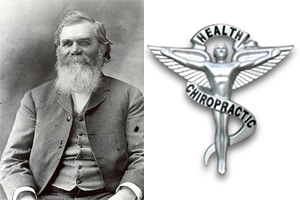 Though the practice of chiropractic is relatively recent in terms of medical treatment, its theory has ancient roots. Hippocrates advised physicians to “get knowledge of the spine, for this is the requisite for many diseases.” Despite this admonishment, the theory of the proper alignment of the spine as being integral to good health did not come into practice until the magnetic healer Daniel David Palmer healed someone by performing a spontaneous spinal adjustment in 1895.
Though the practice of chiropractic is relatively recent in terms of medical treatment, its theory has ancient roots. Hippocrates advised physicians to “get knowledge of the spine, for this is the requisite for many diseases.” Despite this admonishment, the theory of the proper alignment of the spine as being integral to good health did not come into practice until the magnetic healer Daniel David Palmer healed someone by performing a spontaneous spinal adjustment in 1895.
According to the story, Harvey Lillard, a janitor in his office, was working late one night when a particularly noisy fire engine passed by. Palmer noticed that Lillard had not reacted at all, so tried to speak with him, at which point he realized the man was deaf. Lillard related that although he had enjoyed perfect hearing for most of his life, he had been deaf for the past 17 years after he had been working stooped over and heard a “pop” in his back. When he straightened up he discovered he had suddenly become deaf.
When Palmer ran his hand down Lillard’s spine he noticed that one of Lillard’s vertebrae was out of place. He wrote later in his medical journal, “I reasoned that if that vertebra was replaced, the man’s hearing should be restored. With this object in view, a half hour’s talk persuaded Mr. Lillard to allow me to replace it. I racked it into position by using the spinous process as a lever, and soon the man could hear as before.” And thus the first chiropractic adjustment was performed.
Palmer coined the term “chiropractic” from the Greek terms “chiro” (hand) and “practic” (practice). Though Palmer established the first school of chiropractic, the Palmer School & Infirmary of Chiropractic, in 1898 to a public eager to explore alternative medicine, it met with a significant amount of opposition, primarily from the traditional medical establishment. The American Medical Association (AMA) accused Palmer of practicing medicine without a license, and was jailed for 17 days.
D. D. Palmer’s son, B. J. Palmer, took over the school from his father in 1906 and increased the student enrollment. B. J. maintained that chiropractors did not diagnose or treat disease, but rather “analyzed” the situation and performed “adjustments” of spinal subluxations. This did not appease the AMA, who continued for decades to discredit the practice and harass its practitioners both socially and legally.
Finally, in its landmark 1987 ruling in the case of Wilk vs. AMA, the court ruled that the AMA had “engaged in unreasonable restraint of trade and conspiracy,” effectively putting an end to the AMA’s witch hunt. A number of studies done in recent decades have shown the effectiveness of chiropractic, particularly in cases of low back pain, neck pain and headaches.
Today’s chiropractors continue D. D. Palmer’s commitment to establishing a relationship with their patients and treating them in a holistic way that eases pain and restores quality of life without the use of drugs or surgery.

